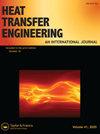Impact of Linear Heating Profiles on Nanofluidic Convection in Enclosure
IF 1.6
4区 工程技术
Q3 ENGINEERING, MECHANICAL
引用次数: 1
Abstract
ABSTRACTThe present study demonstrates the influence of non-uniform heating on the nanofluidic thermal convection in an enclosure by keeping the mean temperature of heating constant. The non-uniform heating is applied by varying the slope of the linear temperature profile from 0° to 60° at an interval of 15°. The investigation is executed numerically following the finite volume discretization technique. Two different cases are taken into consideration: Case A for linearly increasing temperatures, and Case B for linearly decreasing temperatures. The flow structures and heat transfer characteristics are studied for the Rayleigh number from 103 to 106 and the copper-water nanoparticle concentrations from 0 to 0.04, utilizing the streamlines, isotherms, and heatlines. The results reveal that the mean Nusselt number monotonically increases with a rise in slope for all linearly increasing temperature profiles. For the decreasing profiles (Case B), the Nusselt number decreases with a rise in the temperature slope for the lower Rayleigh number (103 and 104); however, a marginal increment is observed at the maximum profile angle for the higher Rayleigh number (105 and 106). This study provides findings helpful for designing thermal devices with the efficient utilization of heating sources.DisclaimerAs a service to authors and researchers we are providing this version of an accepted manuscript (AM). Copyediting, typesetting, and review of the resulting proofs will be undertaken on this manuscript before final publication of the Version of Record (VoR). During production and pre-press, errors may be discovered which could affect the content, and all legal disclaimers that apply to the journal relate to these versions also. Additional informationNotes on contributorsAbhinav Saha Abhinav Saha is a Ph.D. student at Jadavpur University, Kolkata, India. He received his Master’s in Mechanical Engineering in 2012. His research includes computational heat transfer, buoyancy-driven flow of nanofluids, and transport in porous media. His research papers on thermal engineering have been published in international journals and conference proceedings.Nirmalendu Biswas Nirmalendu Biswas graduated from Jadavpur University and did Master’s in Mechanical Engineering from Jadavpur University. He received his Ph.D. in Engineering from Jadavpur University, Kolkata in 2016. He has more than ten years of industrial experience. Presently he is an Assistant Professor in the Department of Power Engineering, Jadavpur University, Kolkata, India since 2019. His research interests include heat transfer, microfluidics, multiphase-flow, energy storage, phase-change material, and bio-fluid mechanics. He has published a number of research papers in international journals and conference proceedings. He is an INAE fellow. He is a life member of ISHMT and IEI.Nirmal K. Manna Nirmal K. Manna is a Professor in the Department of Mechanical Engineering at Jadavpur University, Kolkata, India. He completed his Ph.D. (Mechanical Engineering) from Jadavpur University in 2005, and his Masters in Heat Power from the Indian Institute of Engineering Science and Technology (formerly known as Bengal Engineering College Deemed University) in 1996. He has 4 years of industrial experience. His research interests include the development of CFD code on single- and multi-phase flows, bio-fluid mechanics, free and forced convection, spool valve of HCS, FCI, and premixing. He has published a number of research papers in international journals and conference proceedings.Koushik Ghosh Koushik Ghosh is a Professor in the Department of Mechanical Engineering at Jadavpur University, India. He received his Masters degree from Jadavpur University in 1997 and worked at Bhabha Atomic Research Centre (BARC), India, during 1997-2002. He did his Ph.D. (2007) at Jadavpur University. He worked as a Post-Doctoral Researcher in IRSN, France (2009-2010). His research interests include heat transfer, boiling and condensation, multiphase flow, and transport in porous media. He has published about 50 research papers in various international journals in the area of thermal engineering. He has also published several book chapters and conference papers.线性加热剖面对箱体内纳米流体对流的影响
摘要在保持平均加热温度不变的情况下,研究了非均匀加热对围护结构内纳米流体热对流的影响。不均匀加热是通过改变线性温度曲线的斜率从0°到60°,间隔15°来施加的。采用有限体积离散化技术进行了数值模拟。考虑了两种不同的情况:情况A是线性上升的温度,情况B是线性下降的温度。利用流线、等温线和热线研究了瑞利数为103 ~ 106和铜水纳米颗粒浓度为0 ~ 0.04时的流动结构和传热特性。结果表明,对于所有线性增加的温度曲线,平均努塞尔数随斜率的增加而单调增加。对于递减剖面(情形B),低瑞利数(103和104)的努塞尔数随着温度斜率的增大而减小;然而,在较高瑞利数(105和106)的最大剖面角处观察到边际增量。本研究为设计有效利用热源的热装置提供了有益的发现。免责声明作为对作者和研究人员的服务,我们提供了这个版本的已接受的手稿(AM)。在最终出版版本记录(VoR)之前,将对该手稿进行编辑、排版和审查。在制作和印前,可能会发现可能影响内容的错误,所有适用于期刊的法律免责声明也与这些版本有关。本文作者sabhinav Saha是印度加尔各答Jadavpur大学的博士生。2012年获机械工程硕士学位。他的研究包括计算传热,浮力驱动的纳米流体流动,以及多孔介质中的输运。他在热工程方面的研究论文已在国际期刊和会议论文集上发表。Nirmalendu Biswas毕业于Jadavpur大学,并在Jadavpur大学获得机械工程硕士学位。他于2016年获得加尔各答Jadavpur大学工程学博士学位。他有十多年的行业经验。目前,他自2019年起担任印度加尔各答Jadavpur大学动力工程系助理教授。主要研究方向为热传导、微流体、多相流、储能、相变材料、生物流体力学。他在国际期刊和会议论文集上发表了多篇研究论文。他是INAE的研究员。他是ISHMT和IEI的终身成员。Nirmal K. Manna是印度加尔各答Jadavpur大学机械工程系的教授。他于2005年在Jadavpur大学获得机械工程博士学位,并于1996年在印度工程科学与技术学院(前身为孟加拉工程学院)获得热电硕士学位。他有4年的行业经验。主要研究方向为单相和多相流的CFD程序开发、生物流体力学、自由对流和强制对流、HCS滑阀、FCI、预混炼等。他在国际期刊和会议论文集上发表了多篇研究论文。Koushik Ghosh是印度Jadavpur大学机械工程系的教授。他于1997年获得贾达夫普尔大学硕士学位,1997-2002年在印度巴巴原子研究中心(BARC)工作。他在Jadavpur大学获得博士学位(2007年)。2009-2010年在法国IRSN任博士后研究员。主要研究方向为传热、沸腾与冷凝、多相流、多孔介质输运等。他在各种国际期刊上发表了约50篇热工领域的研究论文。他还出版了几本书的章节和会议论文。
本文章由计算机程序翻译,如有差异,请以英文原文为准。
求助全文
约1分钟内获得全文
求助全文
来源期刊

Heat Transfer Engineering
工程技术-工程:机械
CiteScore
4.50
自引率
17.40%
发文量
111
审稿时长
7.5 months
期刊介绍:
Publishing 18 issues per year, Heat Transfer Engineering is an unparalleled resource for key advances in the field of heat transfer for the practicing engineer and other workers in the field. The journal publishes analytical, numerical, and experimental articles of lasting interest in the general area of heat-mass transfer and the related fluid mechanics and thermodynamics.
In a clear, easy-to-read format, the journal includes refereed papers of original work, state-of-the-art reviews, articles on new developments in equipment or practices, reviews of fundamentals, heat in history articles, book reviews, news items on people and companies in the field, advertising, and any other items that may be appropriate.
All submitted manuscripts are subject to initial appraisal by the Editor and/or selected members of the Editorial Board, and, if found suitable for further consideration, to peer review by independent, anonymous expert referees.
 求助内容:
求助内容: 应助结果提醒方式:
应助结果提醒方式:


